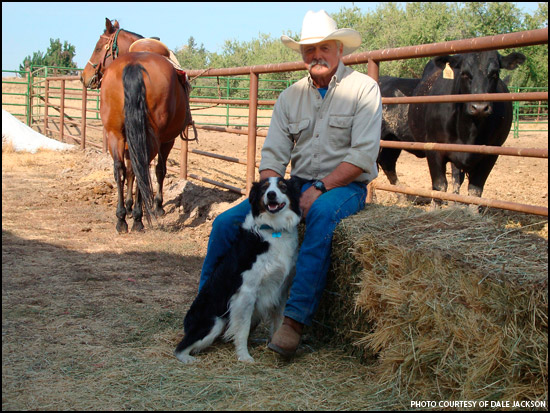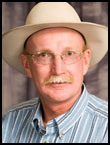MANAGEMENT...

Instructions Cattlemen Can Use
Manual outlines straightforward, applicable tips for quality production.
It's no wonder they're often the first things to be tossed when opening a new gadget.
Instruction manuals these days are written in a dozen languages and folded like origami — they can make pressing the "on" button into a five-step process, but leave out some other basics.
With that said, Oakdale, Calif., rancher Dale Jackson was pleasantly surprised when he picked up a copy of the Best Practices Manual (BPM), a guide to targeting the Certified Angus Beef® (CAB®) brand for cow-calf producers.
"It's easy to read, it's easy to understand, and it has things in there that cattlemen can relate to," Jackson says. Bull customers of his J3 Ranch received a BPM this year and a follow-up from Jackson to help them implement production strategies.
"One of the things we're trying to do is to get our commercial cattlemen to appreciate the value of the premiums that are associated with cattle that will grade higher than normal," he says. "Our challenge has always been finding a way to communicate the value of high-grading carcass traits to commercial bull buyers who do not participate in grid premiums, and the Best Practices Manual is the single most effective tool we now employ to get the CAB message to our customers."
Jackson helped them focus on the marketing section. As a result, he now has bull customers who are marketing calves through grid programs, age- and source-verification and qualifying to sell their calves as a natural product.
The producers are finally realizing profit they've been missing out on, he says: "It's been rewarding for those guys who have embraced it."
Kevin Cantrelle is one of those guys. The Raymond, Calif., rancher started enrolling his cattle in the AngusSource® program after reading the manual.
"Source-verifying our cattle opened up the markets for some exporting," Cantrelle says. "It also allows our calves' potential buyers to see the genetic makeup of our bull battery." Both, he notes, added more dollars to his calves' worth at sale.
Turn Frost-damaged Corn Into Silage
This year, late-seeded corn destined for grain may have been damaged by frost, but it still can be used.
"The weather continues to complicate the farming and ranching scene," North Dakota State University (NDSU) Extension dairy specialist J.W. Schroeder says. "If your corn doesn't make grain, then silage may be an option, providing ruminant livestock exist in the area to consume it. Make sure you put the corn up right to avoid losses due to spoilage from improper storage." Read more.
Using Cornstalks as a Feedstuff for Beef Cattle
As fall corn harvest and calf weaning arrive, the thoughts of many cattle producers turn to determining what sources they will use to background calves and feed cows through fall and into winter. One greatly underutilized resource for fall grazing is cornstalk residue.
This fall's Minnesota corn crop is estimated at somewhere around 1.2 billion bushels (bu.) harvested from 7.7 million acres. The residue that remains after corn harvest can be effectively used as cattle feed, with an average total digestible nutrient (TDN) concentration of 50%-55% and a crude protein (CP) concentration of 4%-6%. Although these values are low, it is important to recognize that after weaning, the nutrient requirements for cows are also very low, and can nearly be met with cornstalk grazing alone. Read more.

Ron Torell
Back to Basics
Cash for gummers
We have all followed the government-funded "Cash for Clunkers" program designed to encourage U.S. consumers to trade in their low-performance, gas-guzzler vehicles for more fuel-efficient new models. The Cash for Clunkers program stimulated the economy, put autoworkers back to work and saved fuel — all at taxpayers' expense.
I propose we implement a "Cash for Gummers" program. We could model the eligibility criteria to the already established requirements for Cash for Clunkers. Only poor-performing animals or cattle in the gummer stage of production would qualify. All qualifying animals would be required to be harvested, then replaced with a yearling or first-calf heifer with a stacked pedigree or package of expected progeny differences (EPDs). Read more.
Keys to Bull Performance
Ninety percent of beef producers use bulls in natural breeding, guest speaker Roger Ellis told cattlemen at the 2009 Cattlemen's Day hosted Oct. 10 by Clemson University Extension and the South Carolina Cattlemen's Association. The program was conducted at the Edisto Research and Education Center. The goal in a planned breeding program is to achieve the highest rate of pregnancy early in the breeding season.
Ellis, a beef cattle veterinarian at the University of Georgia, said the four key attributes a bull must have are that he:
• is physically capable of breeding;
• is willing to mate;
• has the capacity to produce semen; and
• has functionally normal spermatozoa.
The health of a bull's spermatozoa contributes to the survival of the embryo, Ellis said. It's not a widely published fact, but the beef animal is not a highly fertile animal, and only about 65% of fertilizations become pregnancies.
That means 25%-35% of pregnancies are lost in the cows. Those losses often are blamed on the bull, and it can be the bull's fault in some cases, Ellis said.
For example, genetic deficiencies in the bull's spermatozoa may mean that though it is capable of fertilization, it is not capable of sustaining an embryo.
"We're looking to maximize the potential of that bull over its breeding lifetime," Ellis said.
Optimizing Meat Quality with Maximum Efficiency
ASAS symposium looks at factors affecting marbling from all angles.
Marbling can be fickle. Everything, from genetics to growth technologies and production systems, affects the way and how much intramuscular fat cattle will deposit.
This summer an American Society of Animal Science (ASAS) symposium focused on getting the most meat quality with maximum efficiency.
J. Daryl Tatum, Colorado State University (CSU), began by citing advantages and disadvantages of implants and beta-agonists. The flavor driver, marbling, interacts with growth at the cellular level, according to Bradley Johnson, Texas Tech University. Stepping outside the animal, Ivan Rush, University of Nebraska, discussed a system that could produce higher quality and greater efficiencies without a change in technologies. Mark Enns, CSU, talked about selection for marbling to help producers capitalize on the trait's relatively high heritability.
Read more about what these speakers had to say.

Kris Ringwall
Beef Talk
Producers are earning premiums for age and source verification.
In the last decade, there has been a movement to reconnect the art of food production from the producer to the consumer. While the reasons may vary, this new dimension in agriculture is growing.
Age and source verification for meat and source verification for many more food products are management processes that seem to please consumers. While the connection back to the actual producer may be marginal, the knowledge about the food we eat brings some contentment to human well-being.
For beef producers, age- and source-verified cattle are earning premiums of $25 to $35 per carcass. The premiums vary depending on the program, but cash is being offered for ranch- or feedlot-verified cattle through to the packer. Read more.
'Hog Cam' Could Give Upper Hand on Feral Hogs
New, inexpensive automatic cameras best weapon in feral-hog war.
In Texas, feral hogs cause an estimated $52 million in damage to crops and pastures annually, said Billy Higginbotham, AgriLife Extension wildlife and fisheries specialist. "And that does not include damage to wildlife food plots, wildlife feeds and feeders, or to recreational areas like parks, golf courses and landscapes."
As for feral hogs, knowing when, how many and where they visit is critical to controlling them, said the Texas AgriLife Extension Service expert. And one of the best ways to monitor feral hog activity, either with trapping or hunting in mind, is by using remote-sensing cameras. Read more.
New Products
Industry affiliates provide a wide array of products and services to assist you on the farm and ranch. Here's an assortment of new products to hit the market in the last few months.
• Bovi-Sheld Gold© HB, by Pfizer Animal Health
• Model 8117 Livestock Trailer, by Featherlite
• RespondTM line of cattle products, by AgriLabs
• EcoFount 1 and 2, by Ritchie Industries
• CCX770 Cob Harvesters, by Vermeer Corp.
• BC11 Series Bale Carriers, by John Deere
• Tidy Trax shoe covers, by Tidy Trax
• Gleaner R6 and A6 series combines, by Agco
• H6000 Series heavy-duty disc mowers, by New Holland




